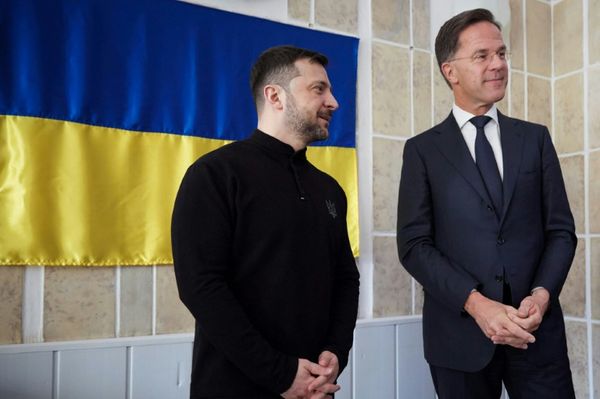
A decades-old mural at 71st Street and Jeffery Avenue by the late, revered artistic duo Mitchell Caton and Calvin Jones has been lauded as “a masterpiece,” its presence “like having a Van Gogh on the block.”
But the artwork, celebrating Black creativity, nearly was lost to history last month when another artist, with a roller and fresh paint, began painting over the piece, preparing the space for a new mural he thought he had permission to do there.
Only quick action by a business leader stopped him and saved most of the images — which had been painstakingly restored over the preceding weeks by artists Dorian Sylvain, Damon Lamar Reed and Bernard Williams, who aimed to make it accessible for another generation.
Sylvain says that, when she heard what happened, “My heart dropped. It’s one of the oldest murals in the city,” and this happened “right after we finished revitalizing it.”

She estimates that roughly 10% of the artwork — titled “Builders of the Cultural Present” and originally completed in 1981 — was covered with a “yellowy-beige” coat of paint.
“The whole thing was just really stunning,” she says. “It took us a minute to digest it.”

The artist who started painting over the piece, Quentin Crockett, says he’d been hired by a community activist to paint another mural there — highlighting victims of violence — because the Caton-Jones mural had been in bad shape. Crockett says he didn’t realize a restoration had been in the works.
“Everybody’s heart was in the right place,” says Crockett, who used to have a studio near the South Shore mural. “Nobody was trying to vandalize or destroy anything. I was caught in the middle as an artist.”
The man he said hired him couldn’t be reached for comment.

Sylvain and her collaborators soon returned and began piecing the artwork back together.
Reed says they could still see “some of the lines” and the texture beneath Crockett’s fresh paint, making it easier to re-create what he’d started to paint over.
“That saved us a lot,” he says.
Sylvain says they also relied on photos that had been taken of the mural, which illustrates the continuity between African and African American art by linking Adinkra symbols and kente cloth patterns to portraits of Chicago cultural figures including the late sculptor Marion Perkins and poet Gwendolyn Brooks.

“We were within moments of losing the whole thing,” says Williams, who, with Reed, restored the same mural in 2001 and also has restored other pieces by Caton and Jones. “If he’d gone another 10 minutes, it could’ve been gone.”
That doesn’t mean it couldn’t have been re-created, but “it would’ve been a massive ordeal,” Williams says.
Caton and Jones created six murals together between 1976 and 1987, all with brushes in contrast to the spray paint popular today with street artists.
The first of those, titled “A Time to Unite,” is at 41st Street and Drexel Avenue and was meant to serve as a call for racial solidarity and for people to fight inequities.
The most recent, titled “Bright Moments, Memories of the Future,” is on the exterior of what’s now the Avalon Regal Theater at 79th Street and Stony Island Avenue. It features Black entertainers including Billie Holiday, Redd Foxx, Louis Armstrong and Aretha Franklin.
Two other pieces still exist. Two are gone.
The works by Caton and Jones share themes, including messages of ancestral heritage, Afrocentric designs and symbols and Black power. They also feature portraiture and an eye-catching color palette that often has been meant to help uplift often-struggling neighborhoods.
Caton died in 1998, Jones in 2010.

The intensively collaborative nature of their complex, stylized compositions was unusual in Chicago and inspired many artists, Sylvain among them. She was the project manager for the recent restoration, done with a $100,000 grant from City Hall’s Department of Cultural Affairs and Special Events.
That creation was “the first mural I ever saw being painted in the neighborhood I grew up in,” Sylvain says. “Their style, the patterning, the colors, the montages — I’ve been influenced a lot by these two artists.
“I want young artists to understand they are part of a tradition.”
While holding a job as a postal worker, Caton was among the pioneers of the mural movement in Chicago and nationwide. His first pieces date to 1969, when he worked on a later version of Bronzeville’s groundbreaking “Wall of Respect.” He went on to paint a couple of dozen visually brilliant and socially critical murals throughout the South Side. But few of those survive today.
Jones was a well-known painter, onetime advertising graphics firm owner and gallery director when he asked Caton if he could help him on one of his murals.
“I’d enjoyed the things he’d done around the city, and I wanted to hang out with him and clean his brushes,” Jones said in a 1998 interview.

Their strengths complemented each other, and they soon became art partners.
Remarkably, Jones was legally blind until he had corneal transplants in the mid-1980s.
Jones was a “master” at figures and portraits, and Caton specialized in “pattern work, color,” Williams says. Both amateur musicians, they also improvised, playing off of each other in jazz-like fashion.
“It was amazing how they worked because they didn’t plan it out ahead of time,” says artist Arlene Turner Crawford, who assisted on the Caton-Jones theater mural and the recent restoration of “Builders of the Cultural Present.”
“Both were excellent draftsmen,” Turner Crawford says. “They designed it on the spot. They just sketched it out on the wall.”
Contributing: Jeff W. Huebner







